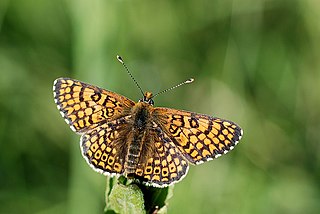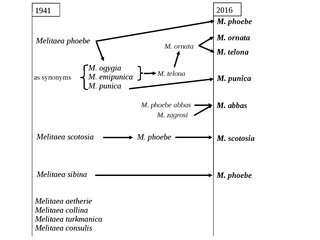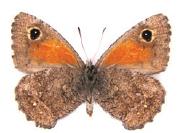
In biology, a hybrid is the offspring resulting from combining the qualities of two organisms of different varieties, species or genera through sexual reproduction. Generally, it means that each cell has genetic material from two different organisms, whereas an individual where some cells are derived from a different organism is called a chimera. Hybrids are not always intermediates between their parents, but can show hybrid vigor, sometimes growing larger or taller than either parent. The concept of a hybrid is interpreted differently in animal and plant breeding, where there is interest in the individual parentage. In genetics, attention is focused on the numbers of chromosomes. In taxonomy, a key question is how closely related the parent species are.

Fragaria is a genus of flowering plants in the rose family, Rosaceae, commonly known as strawberries for their edible fruits. There are more than 20 described species and many hybrids and cultivars. The most common strawberries grown commercially are cultivars of the garden strawberry, a hybrid known as Fragaria × ananassa. Strawberries have a taste that varies by cultivar, and ranges from quite sweet to rather tart. Strawberries are an important commercial fruit crop, widely grown in all temperate regions of the world.

Hamearis lucina, the Duke of Burgundy, the only member of the genus Hamearis, is a European butterfly in the family Riodinidae. For many years, it was known as the "Duke of Burgundy fritillary", because the adult's chequered pattern is strongly reminiscent of "true" fritillaries of the family Nymphalidae.

The marsh fritillary is a butterfly of the family Nymphalidae. Commonly distributed in the Palearctic region, the marsh fritillary's common name derives from one of its several habitats, marshland. The prolonged larval stage lasts for approximately seven to eight months and includes a period of hibernation over the winter. The larvae are dependent on the host food plant Succisa pratensis not only for feeding but also for hibernation, because silken webs are formed on the host plant as the gregarious larvae enter hibernation. Females lay eggs in batches on the host plant and are, like other batch-layers, selective about the location of oviposition because offspring survivorship levels for batch-layers are more tied to location selection than they are for single-egg layers.

The Glanville fritillary is a butterfly of the family Nymphalidae. It is named for the naturalist who discovered it and the checkerboard pattern on its wings. These butterflies live in almost all of Europe, especially Finland, and in parts of northwest Africa. They are absent from the far north of Europe and parts of the Iberian Peninsula. To the east they are found across the Palearctic.

Limenitis arthemis, the red-spotted purple or white admiral, is a North American butterfly species in the cosmopolitan genus Limenitis. It has been studied for its evolution of mimicry, and for the several stable hybrid wing patterns within this nominal species; it is one of the most dramatic examples of hybridization between non-mimetic and mimetic populations.

Introgression, also known as introgressive hybridization, in genetics is the transfer of genetic material from one species into the gene pool of another by the repeated backcrossing of an interspecific hybrid with one of its parent species. Introgression is a long-term process, even when artificial; it may take many hybrid generations before significant backcrossing occurs. This process is distinct from most forms of gene flow in that it occurs between two populations of different species, rather than two populations of the same species.
The mechanisms of reproductive isolation are a collection of evolutionary mechanisms, behaviors and physiological processes critical for speciation. They prevent members of different species from producing offspring, or ensure that any offspring are sterile. These barriers maintain the integrity of a species by reducing gene flow between related species.

Colias is a genus of butterflies in the family Pieridae. They are often called clouded yellows in the Palearctic and sulphurs in North America. The closest living relative is the genus Zerene, which is sometimes included in Colias.

The Uncompahgre fritillarybutterfly is a species of butterfly in the Order Lepidoptera: Family Nymphalidae that is endemic to Colorado, USA.

The regal fritillary is a striking nymphalid butterfly found among some of the remaining tallgrass and mixed-grass prairies in the east-central United States. This prairie-specialist butterfly has a characteristic deep orange color and unmistakable dark hindwings with two bands of spots. On the female, both bands of spots are white. However, on the male, the outer band of spots is orange in color. Females also tend to be slightly larger than males. The ventral surface of the hindwings is olive brown to black in color with bold silvery white spots. The wingspan of S. idalia usually measures 68–105 millimetres (2.7–4.1 in). Flight is in the summertime from approximately June to September and adults tend to be swift in flight, coasting close to the ground. It is listed as a species of special concern and believed extirpated in the US state of Connecticut.

Euptoieta claudia, the variegated fritillary, is a North and South American butterfly in the family Nymphalidae. Even though the variegated fritillary has some very different characteristics from the Speyeria fritillaries, it is still closely related to them. Some of the differences are: variegated fritillaries have two or three broods per year vs. one per year in Speyeria; they are nomadic vs. sedentary; and they use a wide range of host plants vs. just violets. And because of their use of passionflowers as a host plant, variegated fritillaries also have taxonomic links to the heliconians. Their flight is low and swift, but even when resting or nectaring, this species is extremely difficult to approach, and, because of this, its genus name was taken from the Greek word euptoietos meaning "easily scared".

Melitaea ornata, the eastern knapweed fritillary, is a butterfly in the family Nymphalidae. The species rank of Melitaea ornata was only very recently recognised by two research groups independently. They realized that there was an unrecognised species in Europe under the name of M. phoebe. The separation of this cryptic species was based on larval morphology from the fourth instar onwards. M. phoebe larvae have a black head capsule while the larvae of this recently recognised Ponto-Mediterranean species have a brick-red head capsule. The separation of the two taxa was also supported by the results of enzyme electrophoresis study. Based on these observations, the name M. telona Fruhstorfer was taken into use for this species. In a recent molecular study, the M. phoebe group forms a monophyletic clade within the subgenus Didymaeformia. Although that study provided important results regarding the systematics of the genus, the members of the phoebe species group were poorly represented, and the need for a detailed examination of this group remained. One of the important results was the corroboration of the species rank of M. telona and the suggestion that the taxon punica may represent a separate species from both M. telona and M. phoebe. Another recent study on the morphometry of genitalia in males and females of the phoebe species group provided additional information. An analysis of a large number of specimens from the Palaearctic showed that Melitaea telona is not restricted to the Ponto-Mediterranean region since several new localities were found, including the Orenburg region (Russia), northern Iran and the easternmost border of Kazakhstan. Since the name ornata described by Hugo Theodor Christoph in 1893 is older than the name telona, the authors began to use M. ornata as the valid name for this species following the rule of priority. Recently, it has also been indicated that M. telonasensu stricto from Israel and M. ornata are different taxa. Previous morphometrical studies have already revealed small differences in the genital structures of the males but the authors interpreted the difference as a well-pronounced intra-specific difference. In contrast, molecular data clearly showed that the two taxa are genetically distinct from each other. Based on the results of the analysis of seven genes, Tóth et al. (2014) concluded that M. telona is not a subspecies of M. ornata but a species in its own right.

Auca coctei is a butterfly of the family Nymphalidae. It is found in Chile and Argentina.
Polyommatus australorossicus, the South-Russian blue, is a butterfly species in the family Lycaenidae. It was described by Vladimir A. Lukhtanov and Alexander V. Dantchenko in 2017 and is found in southern Russia in the Caucasus Mountains.
Polyommatus nephohiptamenos, or Higgins's anomalous blue, is a butterfly of the family Lycaenidae described by J. Brown and John G. Coutsis in 1978. It has an IUCN Red List status of near threatened.

Ophioglossum reticulatum, the netted adder's-tongue, is a species of fern in the family Ophioglossaceae. It has a pantropical/pansubtropical distribution; Latin America, the Caribbean, Sub-Saharan Africa, Madagascar, Yemen, the Indian Subcontinent, Southeast Asia, warmer parts of China, Malesia, Korea, Japan, and many tropical islands. A hexaploid, it has the highest number of chromosomes of any plant, 720. Its leaves—or leaf, individuals only grow one per year—are edible, and are regularly consumed by people in Africa and Asia.












